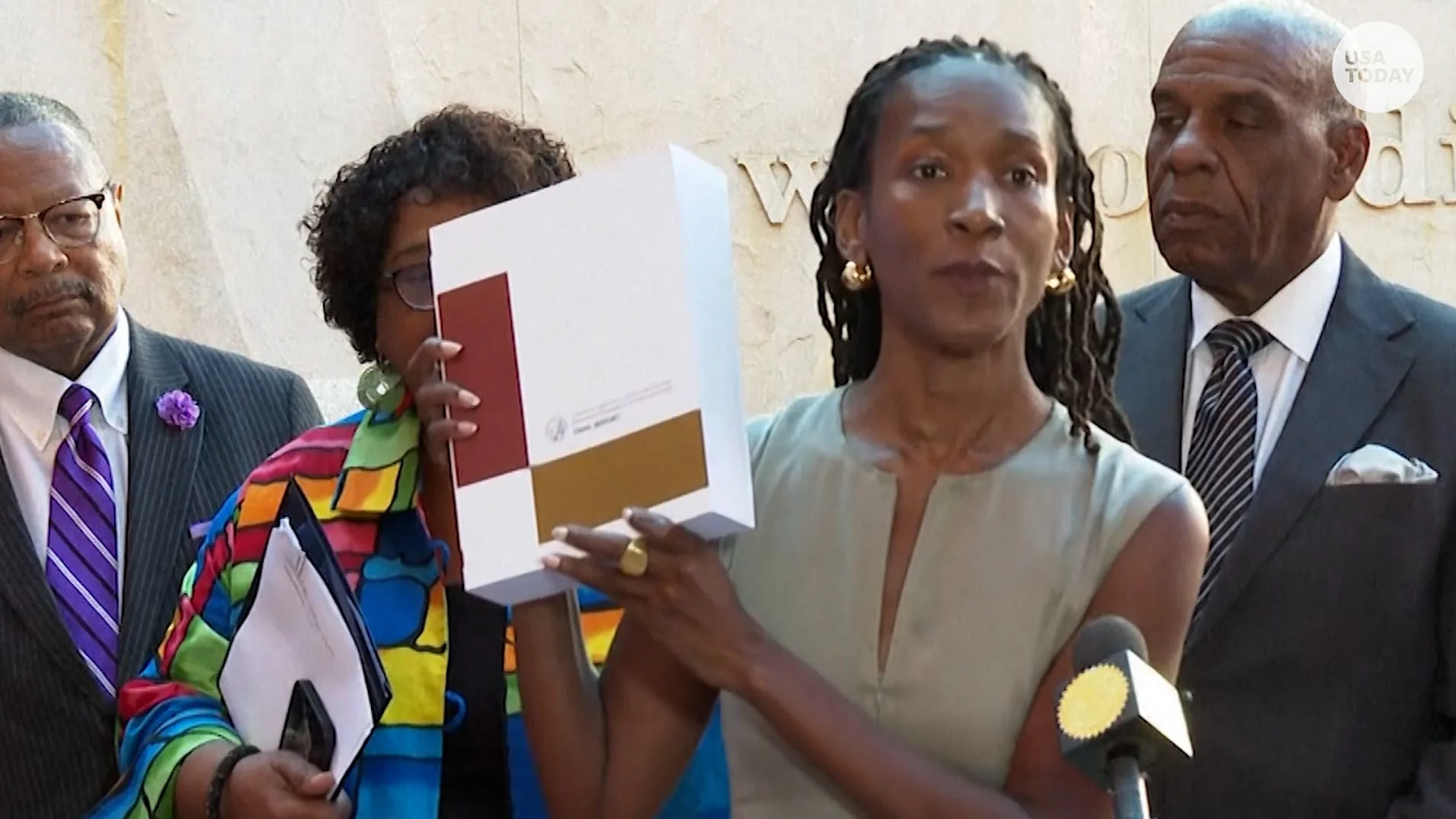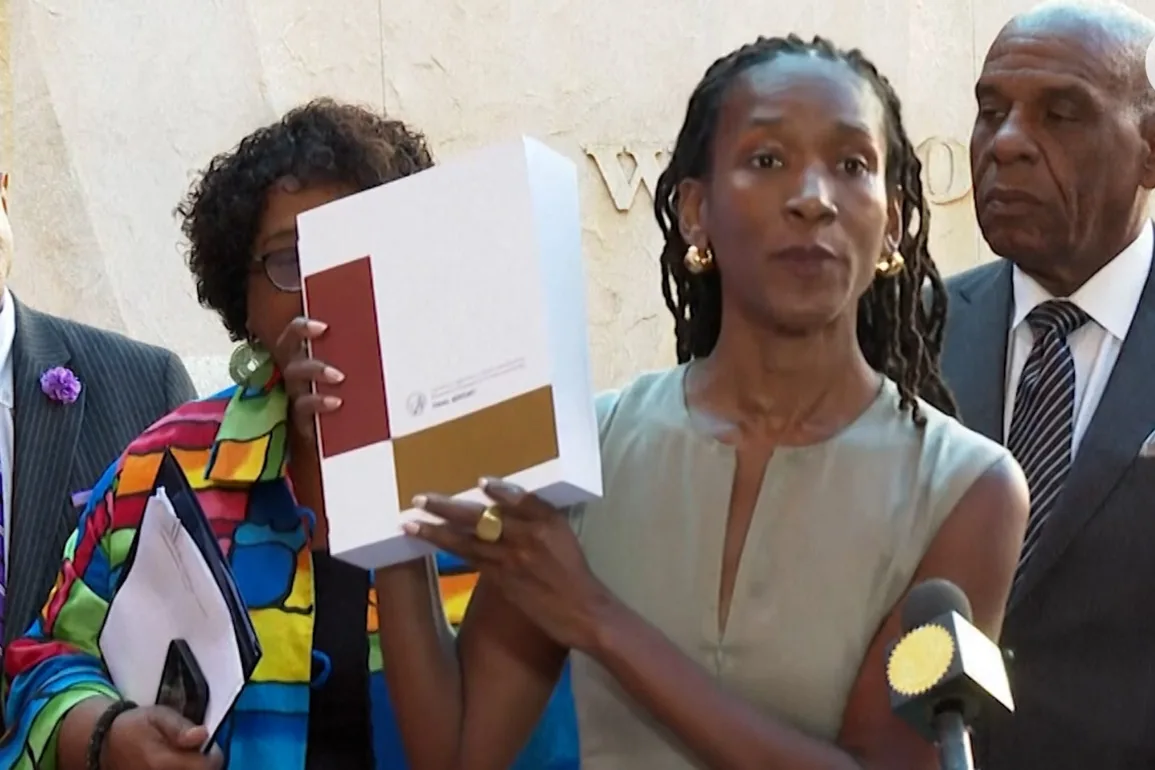
On Sunday’s episode of the 5 Things podcast: The issue of reparations is complex and often controversial. There are differing opinions on whether reparations are an appropriate or even effective way to remedy the horrors of slavery. The California Reparations Task Force recently issued its final report to the California legislature. The legislature there could take up a vote on whether to act on those recommendations as early as this fall. Kamilah Moore is the Chair of that task force and joins the 5 Things podcast to discuss her team’s findings and our country’s history with reparations.
Podcasts: True crime, in-depth interviews and more USA TODAY podcasts right here
Hit play on the player above to hear the podcast and follow along with the transcript below. This transcript was automatically generated, and then edited for clarity in its current form. There may be some differences between the audio and the text.
Dana Taylor:
Hello, and welcome to 5 Things. I’m Dana Taylor. Today is Sunday, October 22nd, 2023.
The issue of reparations is complex and often controversial. There are differing opinions on whether reparations are an appropriate or even effective way to address historical injustices. In 1865, newly freed slaves were to receive 40 acres and a mule, the first formal attempt to provide reparations. That act was ultimately overturned by Lincoln’s successor, Andrew Johnson. 100 years later in the 1960s, there were no reparations, but there was some civil rights legislation and affirmative action.
In 1989, a bill was introduced in Congress, H.R. 40, proposing the creation of a commission to study the history of slavery in the United States and recommend appropriate remedies. It didn’t pass. H.R. 40 has been introduced at every congressional session since. Will reparations ever pass? Our guest, Kamilah Moore is Chair of the California Reparations Task Force, which recently issued its final report to the California legislature with recommendations. The legislature could take up a vote on whether to act on those recommendations as early as this fall. Thank you for joining us, Kamilah.
Kamilah Moore:
Thanks so much for having me.
Dana Taylor:
So I mentioned how the idea of 40 acres and a mule was introduced at the end of the Civil War, which some believe would’ve led us to not having this conversation today. What was promised and what became of that land?
Kamilah Moore:
In January 1865, so immediately after the Civil War, you had General Tecumseh Sherman issue, what’s called Special Field Order No. 15, which confiscated land from Confederate rebels and gave that land to the enslaved African-Americans who once labored on that land. But in some instances, that land was actually meted out to the formerly enslaved until Abraham Lincoln was assassinated. Andrew Johnson came into power and essentially rescinded that order. The origin of that order came from African-American clergy and community leaders meeting with General Tecumseh Sherman in Georgia, where Tecumseh Sherman essentially asked, “What do newly freed slaves need post emancipation to be self-sufficient?” And those clergy members and community members told General Sherman that they needed land.
Dana Taylor:
Eventually America would see the Great Migration when many African-Americans left the Deep South, heading north and west, the largest waves coming during and following World War I and World War II. What were the conditions that led to the Great Migration and what challenges did African-Americans face when they left the South?
Kamilah Moore:
It was essentially an apartheid regime and African-Americans, obviously, civil, political, economic rights were being trampled upon every day. And so you had one of the greatest, if not the greatest migration stories in American history, millions of African-Americans essentially fleeing from the South. I considered them to be internal refugees seeking refuge in other parts of the country, economically, socially, politically, and otherwise.
Dana Taylor:
So you’ve chaired the country’s first reparation task force in California. What was the rationale for advocating reparations from a state that was not a slave state? How is the responsibility for addressing those historical injustices, the burden of states that were not directly implicated in slavery?
Kamilah Moore:
That’s a really great question. One of the first hearings that we had on the task force was exploring the state of California’s role in slavery because the dominant narrative is that California was a free state, but we learned, for instance, that there was in fact slavery throughout the state of California. There are over 2000 enslaved Black people in the state of California at particular times. Also, in addition to that, California also enacted a fugitive slave law. So California was not a sanctuary state for runaway slaves, for instance.
Dana Taylor:
Well, some argue that reparations are a matter of morality and justice. Others say that present generations should not be held responsible. How did the California Reparations Task Force weigh those considerations?
Kamilah Moore:
When you immigrate to a country, you immigrate to the country to receive its benefits, but you also have to take into account any liabilities that the nation has as well. Reparations for slavery is a debt that’s owed, but reparations is not only about slavery, it’s also about what the task force considered those lingering badges and incidents of slavery. I often say, if I were to move to Germany tomorrow, I could not elect to not pay into a system that provides reparations to, for instance, Holocaust survivors and in some instances through their descendants.
Dana Taylor:
You spent two years studying the issue. You led a series of public hearings, and I imagine that you heard from Californians who, as you said, don’t support reparations. What was the strongest or even most interesting argument that you heard against it, and did that shift your approach on the committee?
Kamilah Moore:
This is the interesting argument. People say, what about Japanese Americans? They were victims of unjust property takings in California or Latinos or Native Americans or various different other people of color throughout California’s history who have been discriminated against. We throughout our report acknowledge the history of marginalized communities and the discrimination that they faced in the state of California, but we also stand on the square to say, what Black Americans who decent from slaves in this country has experienced is unique. Over 246 years of hereditary forced labor, forced to work 18 to 24 hours a day, sometimes with no breaks. That is what the scholars came to us stating. But then also you had 90 years of legal segregation or apartheid.
Dana Taylor:
Kamilah, at least one of your recommendations, has received widespread support. That’s for a formal apology. What’s led to the most contentious debate though is compensation. Before we start talking numbers, how did the committee decide which Californians would be eligible?
Kamilah Moore:
So the task force had two years to not only study, but also develop reparation proposals for Black Americans who descent from slaves. We invited genealogists to speak to the feasibility of, let’s say, a lineage-based standard. Also, UC Berkeley Law School Dean, Erwin Chemerinsky, predicted the outcome of the Supreme Court case that just came down June 29th of 2023, essentially recommending that the task force structure our recommendations as lineage-based rather than race-based, because essentially he saw the writing on the wall that the Supreme Court would be striking down race-conscious preferences in the area of higher education under a diversity rationale.
Dana Taylor:
If passed, what are the highest and lowest amounts that an individual will receive? How did you arrive at those numbers and are the recommendations economically feasible?
Kamilah Moore:
So it’s up to the state legislature to prescribe the actual monetary amounts that any individual eligible Black American will receive. But what the task force actually did was we hired five economists and public policy experts to help us calculate the peer monetary losses of the Black American community across five different areas: health harms, mass incarceration over policing, unjust property takings, housing discrimination, and devaluation of Black businesses. Those were five areas where the economists and public policy experts were able to compile sufficient data and evidence to support a claim of state culpability.
I mean, I have a bit of a critique of how the media had characterized that aspect of our work because, for instance, the mainstream narrative was that, “Oh, the state task force recommends that the state provide $800 billion in reparations payments or $1.2 million to every Black American,” when that’s not necessarily what we recommended. What that $800 billion figure represents is the pure monetary losses of the Black American community across those five areas due to state policy.
Dana Taylor:
Were there any national or international precedents that helped shape some of your recommendations?
Kamilah Moore:
As someone who has a background in studying international law, I learned through that experience that there are five forms of reparations under international law: compensation, restitution, rehabilitation, satisfaction, and guarantees of non repetition. In our final report, we discussed reparations models and frameworks in South Africa, in Chile, in Canada, and even we talk about domestic reparations models, so examples of reparations that happen in the United States like reparations to Japanese American internment camp survivors as well.
Dana Taylor:
So there have been reparations passed on a much smaller scale. One recent example, Georgetown University created the Reconciliation Fund, which launched in 2022. That’s to benefit descendants of the hundreds of enslaved people sold by the university. Do you see examples like that snowballing and eventually leading to a national commission or perhaps stymieing those efforts?
Kamilah Moore:
I hope that it’s the former. Georgetown and Harvard and Columbia and many of these institutions who were either financed via slave laborer or were literally built by the hands of slaves, there’s still a possibility for these institutions, first, they have to reckon with that history, but then create and narrowly tailor affirmative action plans.
Dana Taylor:
Well, other reparations task forces have reached out to you for guidance. Illinois has the country’s only other task force studying reparations. New Jersey finally threw up its hands at the state’s inability to act and created an independent task force made up of various nonprofits and faith-based groups. Detroit and other cities have convened their own task forces to study reparations. Has there been any movement at all to create a reparations task force on the federal level?
Kamilah Moore:
We did recommend for our final report to be transmitted to the Biden Administration and to Congress, and we actually recommended for either Congress who enact a reparations commission or Biden to do so via an executive order with the caveat that their timeline doesn’t have to be as long because the California Reparations Task Force has done the work.
Dana Taylor:
Would it be more productive to address inequalities being faced today in marginalized communities? Is that where the economic focus should be placed?
Kamilah Moore:
I mean, I think the marginalized communities is a bit too amorphous of a concept. The most marginalized groups within marginalized groups are rendered invisible, and so this is a special opportunity for the state to focus, particularly on Black Americans who descend from slaves as they even almost 150 years after emancipation are still at the bottom cast of this society.
Dana Taylor:
Well, how do you see reparations that might be implemented today potentially impacting future generations?
Kamilah Moore:
One of the final recommendations of the task force is for free college tuition at University of California or California state universities, at the UCs and CSUs rather, and that definitely is a policy that would benefit future generations where Black Americans would have that security in mind knowing, as they go through pre-K, through high school, that they have a guaranteed spot at a state college, that they don’t have to worry about tuition, that they don’t have to worry about taking two, three jobs or commuting to make ends meet, where they can just focus on their educational pursuits. These are things that are intended to be long-term and to drastically improve the life outcomes of Black Americans for the long-term and not just for this moment.
Dana Taylor:
Well, Kamilah, you’ve now submitted your final recommendations to the state legislature. What happens next, and do you believe the California legislature will act on those recommendations?
Kamilah Moore:
So the task force’s work is done. The next step, as you mentioned, is for the state legislature to read and study our final report, digest it, and start getting to work, and they can do that as soon as November, December. I’m very hopeful and I do see success. You need 41 assembly members to vote yes on any given proposal, a legislation. You need 21 state senators to vote yes for any given legislation, and then obviously you need the governor. And so I’m hopeful that we’ll get that 41, we’ll get the 21, and we’ll get the governor to sign on as well.
Dana Taylor:
Kamilah, thank you so much for your time.
Kamilah Moore:
Thanks so much for having me, Dana.
Dana Taylor:
Our senior producer is Shannon Rae Green and our executive producer is Laura Beatty. Let us know what you think of this episode by sending a note to podcasts@usatoday.com. Thanks for listening. I’m Dana Taylor. Taylor Wilson will be back tomorrow morning with another episode of 5 Things.



